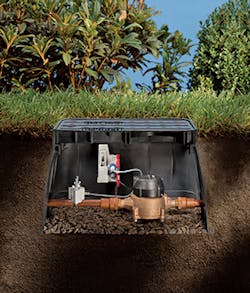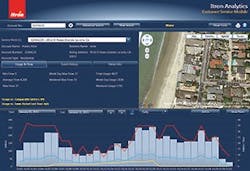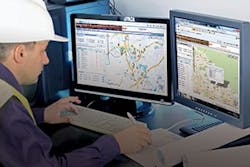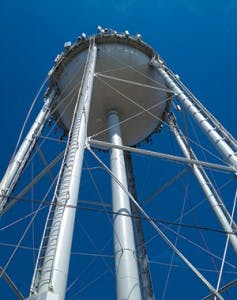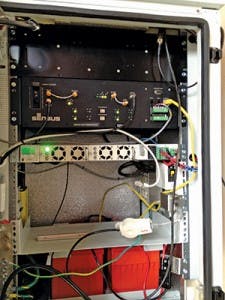The reasons to migrate to Advanced Metering Infrastructure (AMI) have been firmly established. AMI technology helps utilities better manage water usage for adequate sustainable water in the future. Utilities can be more proactive, serve as better stewards of water resources, and help ratepayers do the same. Money savings follow. Nevertheless, some have trouble rationalizing the initial cost, especially in the face of reduced operating budgets, mounting repairs of aging infrastructure, and increasing customer demand.
Mastering The Meter…and Beyond
Every municipality knows that water meters are a utility’s cash register, making accurate measuring the key to revenue. And yet, there’s so much more potential. “It’s not about a meter read; it’s about information management,” emphasizes Ian MacLeod, marketing and brand champion with Master Meter Inc., a pioneer in the design, development, and manufacturing of precision-accurate water meter systems. It’s time for a different message. “Utilities already get accurate monthly readings, but what do they do with data?”
Itron’s Analytics Customer Service Module
Utilities are still deciding what to do with the information—but they are quickly figuring it out. They’re asking questions and making checklists. They’re conducting water audits to find non-revenue water. They’re establishing internal metrics: the number of customer calls and leak conditions.
Utilities are doing more “homework” about AMI. Ample information is available on the Internet, from case studies to webinars to white papers, about how to implement systems and manage data. This has brought about an evolution in the vendor’s role. “It used to be sell, sell, sell,” says MacLeod. “Now, vendors are maturing as consultants and business partners.”
This new role allows them to steer the conversation to the possibilities of what AMI can do. “We, the vendors, can help explain to citizens through public hearings the merits and any perceived issues of the technology from a consulting/business partner aspect,” MacLeod continues.
He describes the vendor’s role as a bridge between the ratepayers and the utilities. It’s important to educate ratepayers about why they should want it too. “They can opt out, but there’s a cost,” MacLeod explains.
The ratepayers’ primary concerns center around privacy. “They’re afraid the utility can see when they’re on vacation or in the shower,” MacLeod speculates. Another concern often expressed involves radio frequency energy. However, smart meters emit less power than a cell phone or garage door opener, posing no danger. This is information vendors can distribute to put ratepayers at ease.
Vendors can help utilities build a better relationship with the ratepayer through other forms of interactive customer engagement as well. “We can help make the ratepayer aware of their usage through smartphone apps for water budgets,” MacLeod states. “Information leads to goals.” He admits that there’s a bit of a “shaming effect” to the tactic of informing a ratepayer of their water consumption footprint in relation to others in their area. However, by helping to eliminate billing surprises, MacLeod believes AMI is gaining respect.
It provides benefits for the utilities, such as reducing billing complaints, lawsuits, and calls to City Hall, while users gain from real-time information, which allows them to take timely, corrective action.
Reducing wasteful use of water is important for everyone. With an increase in water demand and the issue of climate change, conservation is a very important development that MacLeod believes will drive continued adoption of AMI.
“It costs money to pump, treat, and deliver water,” he says. According to EPA, in 2008, America spent $4 billion for the electricity for the treatment, pumping, and delivery of water. “There’s a very real connection between climate change and water production. A growing part of the [AMI] message is the need to reduce our carbon footprint, that water is part of a bigger picture. We must acquire a holistic understanding about the nexus of water and electricity.” To that end, he has been giving presentations about how conservation impacts electricity usage.
For a small utility in a wet area, AMI may not be the best choice, but MacLeod says that “it’s a very real trend.”
Helping Utilities Move Beyond The Basics
The trend began about 10 years ago with a “huge move to technology,” says Dave Hanes, director of strategic marketing for Neptune Technology Group Inc. He says about half the meters in the country are automated now, thanks to “a very significant movement to AMR and AMI that produced more data and more operational efficiency.”
Most utilities did a good job of understanding the basic value, according to John Sala, director of marketing systems for Neptune. They grabbed the low-hanging fruit by making the processes they were already doing, such as billing, complaints, and inquiries, more efficient. “Becoming more efficient was the easy part. Still ahead, the challenge is to do more, and do it better.”
Neptune introduced the original automatic meter reading system, Automatic Reading and Billing, to utilities in 1964. Neptune provides field-proven technology that includes manual readers, mobile, and full-scale fixed network systems. “It started with the water meter: our core product,” elaborates Hanes. “Then we added a reading system.”
The early adopters proved the benefits. “In the early years, people were skeptical that the soft benefits of customer service, reduction of delinquent accounts, and so on would make it hard to develop a business case. It was hard to quantify,” says Hanes. “Now, there are many case studies that prove out the value.”
Sala calls AMI the “great democratizer” because even big utilities have trouble doing more with all of the AMI data. “They all struggle to go to the next level of efficiency beyond billing. They have additional data, but they need to learn what to do with it. It’s a learning curve.”
Not only must the utilities understand the value vendors can deliver through customized reporting and integration with other systems, and figure out what works best for them, but they also have to adapt to a change in process. Some utilities may have to change their behavior to adapt to regulatory changes. Others have to overcome technical impediments, such as ensuring their billing system accepts the new data. System providers can’t “just dump data,” says Hanes. “We have to use the data to provide useful information and knowledge.”
He believes that planning with the end result in mind is important. Any vendor working with a utility should try to understand the customer’s underlying needs: efficiency, reduced delinquencies, loss in workforce (due to retirements or a desire to improve revenue), or customer service.
Different drivers can lead a utility in different directions. Goals for Laredo, TX, included reducing manpower and providing better customer service in the form of leak alerts by implementing an AMI system.
The City of North Bay, Canada, was concerned about water conservation after opening a new treatment facility in 2011. Their goals included tracking non-revenue water by use of alarms for reverse flow and continuous leaks and an equitable billing system for water services.
Of the 16,500 accounts receiving water, its 15,000 residential customers paid a flat rate based on the number of water fixtures in their homes. Equity in billing was impossible because water consumption could not be measured; the residences had no meters. The 1,500 commercial, industrial, and institutional accounts were metered, but their bills were estimated because the meters weren’t reading properly and because there wasn’t enough manpower to manually read the meters.
Although Neptune is not a consultant, Sala says they try to take a consultative approach by getting to know the municipality’s needs before considering a proposal. “If your first opportunity to talk with them is at bid, it’s tough to advise.”
Hanes points out that they see more requests for proposals than bids, which he considers an acknowledgement that municipalities know they can’t compare systems on price alone. “They’re not all equal; functions are not across the board.”
Neptune provides a partner program that allows other application providers to access AMI data without requiring custom program interfaces, with the goal of making AMI data more usable across the utility. Neptune also supports the concept of citizen development. “We want them to be able to roll out their own solutions,” Sala indicates. With the availability of mobility platforms, apps and structure application program interface, utilities have the opportunity for new concepts that allow their customer to get information without buying a module.
The AMR Alternative
Many people have the impression that AMI is the only thing that counts, says Jake Heikkinen, vice president of sales for US, Kamstrup, but a lot of utilities, due to size, geography, or budget, consider automatic meter reading (AMR) the best solution.
The difference between AMI and AMR is the amount and rapidity of information. But, Heikkinen asks, “Who uses hourly data? Sure, it’s used for leak detection and utilities can analyze network consumption patterns, but very few are that far right now.”
He says Kamstrup doesn’t track all the data from all the meters. “If 50,000 meters collect data hourly, that’s a lot of data! We’d need to build another system to evaluate and choose the most important data to evaluate.” Instead, analyzing is done in the meter. If there’s a leak, the meter flags it. “You get only the information you really need with AMR.”
He explains the AMR philosophy of using a drive-by radio system to collect data for billing. “You collect data if something is wrong—leakage, tampering, reverse flow, empty pipe. If there’s an issue, you go to the site and look at the meter. There are three data loggers in the meter. You can see ambient temperature, flow, daily usage/consumption patterns. It’s easy to see what’s going on.”
In rural areas where there’s a great deal of physical distance between meter points, AMR may be a better alternative. Heikkinen says it’s easy to see what fits a utility best, based on several determining factors such as the number of meters and the density. “AMI could be done, but at what cost?” he says. “Sometimes small utilities are surprised at the cost of AMI.”
Even with automatic meter reading, there’s a mindset that utilities can’t afford it. “It requires a big investment: the system, servers, radio concentrators,” Heikkinen says they use existing technology as much as possible to cut down on equipment costs. “We use a smartphone as a reader; it can locate meters on Google maps.”
AMR has been around a long time, but is still developing, Heikkinen believes. He’s also aware that AMI will expand. “We want to be in the meter game if a utility selects an AMI system.”
Kamstrup is a leading manufacturer of system solutions for smart energy and water metering, from fully automatic large-scale to small plug-and-play systems. Their FlowIQ 2100 is an intelligent water meter that minimizes water loss. “Lots of utilities already have a system, but it’s still possible to choose a meter,” says Heikkinen. Compatible with all systems, it is small and durable and features flexible mounting options, alarms for leaks, bursts, tampering, dry conditions, and reverse flow.
A Stands For Action
If a utility is “just interested in meter readings, AMR is a good option. If they want more control, AMI provides information to control the system so they can take action,” says Dan Pinney, director of global water marketing for Sensus.
In fact, he says, often the deciding factor in switching to AMI is based on the desire to do things that are “more responsive.” For example, shut-off valves can be used with a drive-by system, but the trucks have to roll. “You’re not getting the real benefit,” says Pinney. With a fixed-bay system, the utility can control the valves without sending a truck out. “They just push a button.”
The same hardware is used for Wi-Fi drive-by applications and fixed bay deployments. “It’s not a separate system, not separate hardware,” repeats Pinney. The transition from AMR to AMI is a “software switch.” The big difference, he says, is the resolution of the data. “You get a higher resolution in an AMI system, with the ability to do things without trucks rolling. With AMR, you have to code information. If a broken pipe alarms, with AMR, it’s a long time before you see the data. AMI is doing the same thing, but it’s immediate.”
Unfortunately, very few utilities are using a lot of data, Pinney believes. “There’s a lot of room to grow. We’re still in the infancy of what to do with data.” He talks of combining a shut-off valve with GIS and weather data to automatically turn off sprinklers when it’s raining, as well as other potential actions. “More data is always good. The next step is taking action.”
The breadth of information AMI can provide is broad. Pinney talks of tracing non-revenue usage when landscape and construction companies tap fire hydrants. He urges utilities to expand their basic network and “work beyond the meter” by incorporating pressure and vibration sensors that can alert the utility to manhole cover theft, for example.
The normal path is to start with AMR and migrate, he says, although customers must be comfortable with the move. “There’s a natural fear of being locked in to technology,” explains Pinney. The important thing to remember when going from drive-by to AMI is to choose a system that will grow with you. “It must be capable of growing in functionality. Make sure you can upgrade; it should feature a tangible method to grow with you.”
For new applications or fixes for an existing one, new functionality should be attainable on a regular basis without having to change hardware. “Getting the message out that our system can be grown puts customers at ease,” notes Pinney. “It’s not a fixed entity; they’re not locked in on choices. In three years, we may be gathering different data and doing different things with data. You need a system you can upgrade on the fly without changing hardware: a system that grows with you.
In addition to being “migratable,” an AMI system should incorporate time synchronization. “A lot of data is meter-specific,” explains Pinney. “Most often, data from an AMR system is individual, but it’s important to look at it all together so you can compare multiple locations at the same time. A dynamic view of what’s happening—time synchronization—gives you the ability to troubleshoot.”
Despite numerous examples of how AMI technology can benefit utilities, some remain reluctant to make the move. The biggest hesitation Pinney sees is that utilities accustomed to “putting a meter in the ground that lasts 20 years” worry that the battery-powered devices so commonly used now won’t perform for the same period.
“We need to educate,” says Pinney. “It takes understanding of their problems and values.” Those are regionalized, complicating the vendor’s job. However, a flexible system that can be customized for their problems will help utilities connect technology to the value provided.
Flexnet on a water tower at a New Jersey utility
A Message of Flexibility
Many utilities have found value in AMI and are moving to it.
Of the approximately 80 million water meters in the US, around 8–10 million are automated. That means 10% of meters are now AMI. Chris King, global chief regulatory officer with Siemens Smart Grid Solution, mentions a Florida customer with 300,000-plus meters on AMI.
For the 90% still undecided, King says vendors are using traditional approaches to convince them of the value of switching to AMI: webinars, white papers, conferences, blogs, and e-mail newsletters sent to unique targets. “We’re focused on regulatory content and industry consultants,” he explains.
The challenge is getting attention. “People are busy,” acknowledges King. “We start with news and studies, then dig one step down—we interpret, explain the benefits of smart water meters and distribution in context.” He provides information to the customer about how to reduce consumption. “We share encouraging findings, like Coachella Valley in southern California saving 10%.”
Examples are “huge,” he declares. “Many utilities worry that it’s a risk to spend money on this technology. Will it deliver the expected benefits? That’s why we look for case studies.” They help utilities understand the need, and prioritize investments.
Sometimes the examples are negative reminders of what happens without AMI. King recalls recent California storms when pumps were failing. Failures may appear to happen quickly, but they actually develop over time. “If they’re not monitored, people get stranded due to flooding. AMI monitors storm drain levels.” With the old system, King explains, investment typically goes to repair.
Many problems go undetected without AMI. Siemens prepares a cost benefit analysis that assesses the benefits of asset monitoring, leak detection and improved customer service. “We develop a provision for long-term application,” elaborates King. “We go to the investment partners to prioritize investments.”
New technology that includes an analytics program or the E-meter—smart grid software that can run applications—is a priority. “When a utility can do equipment load monitoring—analyze smart grid info to look at how loads vary on a system to see peak load and where they might be exceeding the design parameters—they can see the potential for failure in time to prevent it.” He references the water pipeline failure at UCLA last summer as an example of where this technology could have prevented disaster.
One way to ease the fear utilities express about the move to AMI is to reassure them that the software and hardware have capabilities to add services and applications; what is purchased today won’t be obsolete tomorrow. Open architecture even allows the utility to add compatibility from different suppliers. “The key is [having the] flexibility to do all the things people never imagined when we started,” King concludes.
An Example Is Worth 1,000 Words
One of the most proliferate examples of AMI success is the electric industry. “Electricity made the transition five to 10 years ago,” says Joe Ball, director of marketing water in North America for Itron. Water and gas have seen what electricity has done. “There are certain similarities. They see the value of more frequent data.”
However, the introduction of battery-operated communication modules has slowed the move. “It’s not as big of a push as it was early on.” Unwilling to let that forestall the migration, Itron works with customers at annual users conferences, where they hold sessions and man a booth with product managers who talk to customers about the latest industry developments.
Base station enclosure
at base of a water tower
“We attend other conferences and convey information through publications and speakers,” says Ball. “We’re not selling; we’re educating.”
Asking happy customers partway through deployment to share their experiences or host other utilities, sharing data, can go a long way towards easing concerns. Spreading the message of operational efficiency, improved customer service and accuracy is critical. “In the northeast, there are still indoor installations where [employees] have to read meters in basements,” says Ball. Compared with AMI’s granular hourly data and ability to see customer portals, traditional meter reading doesn’t make sense.
One Itron customer found out the importance of education the hard way and is now sharing their experience with other utilities. In 2010, Madison Water Utility needed to replace its soon-to-be-obsolete Read-o-Matic system, first introduced in 1958. The Wisconsin utility chose an AMI system.
Some of their customers weren’t pleased with their choice. One group of citizens filed a petition with the Public Service Commission, asking them to halt smart meter installations.
A spokesman for the utility believes they were getting misinformation—likely because even the utility had little information to give concerned customers. They had to begin by addressing health concerns. The AMI devices run on AA batteries; when installed in the basement of a house, they emit low-level radio frequencies for approximately 15 seconds per day. Madison Water Utility asked Public Health Madison Dane County to examine those radio frequencies. Researchers found that the radio frequencies emitted during those 15 seconds each day are far lower than RFs from other common devices like laptops, cell phones, and microwaves, creating little in the way of health risks.
By 2014, about 66,000 Madison Water Utility customers had the AMI system. Less than 1%—about 468 customers—chose not to have the new meters installed.
Since this success, other water utilities have been contacting Madison in order to find out how to deal with resistance. The biggest lesson learned, the spokesman indicated, was the importance of “getting out and engaging our customers, doing your best job to educate them about what you’re trying to do.”
Despite positive experiences, Ball recognizes that, to utilities, it “looks like a big bite with new technology. It’s scary.” Itron emphasizes the benefit of rolling the cost into a fixed monthly fee so it’s not a big capital expense for new software. “The back office is folded into the cost.”
Nevertheless, he realizes that the move is difficult for some utilities because it requires a business process change. “The challenge is not the technology, but the transition in business process,” Ball confirms. “Every utility has a process to read meters and input data into a system. Our system automatically reads meters hourly, and pushes information into billing and analytics. That frees up employees to do
different things.”
It’s a shift in the paradigm. Crews are still in neighborhoods working on systems and flushing hydrants, but now they rely on data to catch potential leaks instead of customer calls. “They can be proactive with data, because they know what’s going on in distribution,” adds Ball. This allows the utility to optimize delivery of water. They can cut costs because they’re pumping when energy costs are lower.”
Saving money through leak prevention and efficiency is important to utilities, but Ball says they also appreciate support. “We offer a turn-key solution. We train employees side by side so they get experience before the hand-off.”
Before that final step, Itron offers internal business process workshops to help utilities understand what they’re getting into. “Our strength is our services team: planning and design,” says Ball.
Pilots
Most vendors believe the industry is past the point of pilots, especially if a utility’s neighbor has a similar system. There are two views on pilots, says King. One: The technology is proven, so there’s no need for a pilot; in fact, it slows things down. Two: It is a helpful demonstration and gets buy-in, so sometimes it can speed approval.
“The technology is proven,” says Neptune’s Sala. On the other hand, he admits that there is benefit to individual utilities in trying it out. “They might do a small-scale of a mobile system to make sure the data links correctly.”
But, he hastens to add, while some benefits are incremental, some require full commitment. “Process change is hard if [a system is] not fully implemented or deployed.” To see the benefit of leak detection, for example, AMI must be deployed across the network. But to demonstrate monitoring and the benefit of alerts, it can be effectively deployed on a small scale.
Pinney agrees that pilots are not needed, although he imagines that from the utility’s perspective, it could be considered part of their due diligence. “They might say differently; they might want to evaluate system performance.”
For that reason, he thinks pilots will still be around, but he foresees them evolving. “Meter reading is well established. The onus will be changing in future pilots. Utilities will want to evaluate specific actions. Can I run a remote flushing system accurately?”
Ultimately, because technology doesn’t stand still, pilots will most likely remain valid options.
Head in The Clouds
Sheer numbers often justify utility management. A small utility taking hourly readings from 10,000 customers quickly accumulates a tremendous amount of data. That’s why many are moving to an optional cloud. “Do the math and you’ll see why the cloud option is more pervasive,” says MacLeod. “More utilities are going with hosted systems. It’s very appealing to mid-size and small utilities.”
Cloud-based options are more appealing to utilities that lack an IT department, Hanes believes. Large utilities, on the other hand, typically want to own and control their data.
Utilities are very good at knowing what their system does, Pinney explains. However, when branching out into new directions, “it’s good to get help. A utility’s expertise is taking action. They don’t need to get diverted by all this data.”
Everyone needs help with analysis, Pinny believes. “There’s always something new.”
Ball considers Itron’s total AMI cloud-managed service a supplement for the staff. “Our operation operates the system,” he explains.
Migration
For many utilities, moving to AMI is a “huge risk,” says Hanes. “The biggest risk is—will it last? Today’s decision will go into the future.” Neptune’s systems offer forward innovation and backward compatibility. “Our system lasts 20 years.”
Migration is important. While it’s possible with some systems to start small by beginning with mobile and adding collectors, says Hanes to improve possibility of a pay back, it’s better to migrate sooner than later.
Doing nothing has a price, Sala points out. Failure to migrate could be a missed opportunity, leaving utilities in the “future tech envy cycle.” He advises seeking information from vendors and neighbor utilities to discover the trends in technology before making a decision.
As Heikkinen says, “Technology should solve practical problems.”
